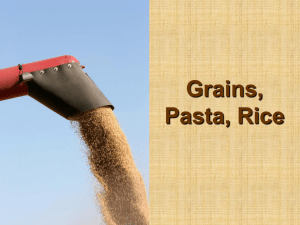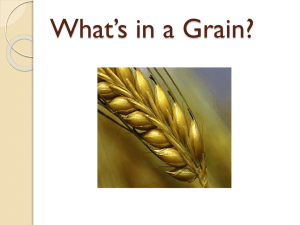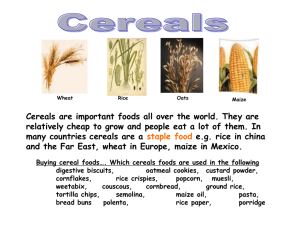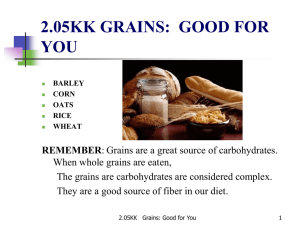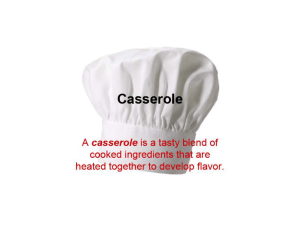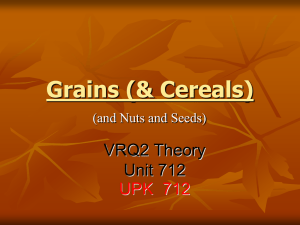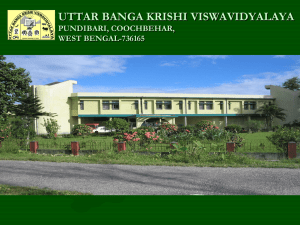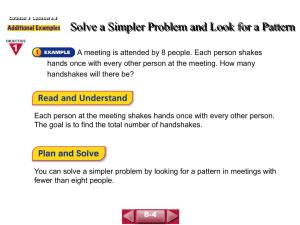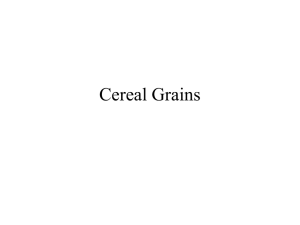Grains, Pasta, Rice PowerPoint
advertisement
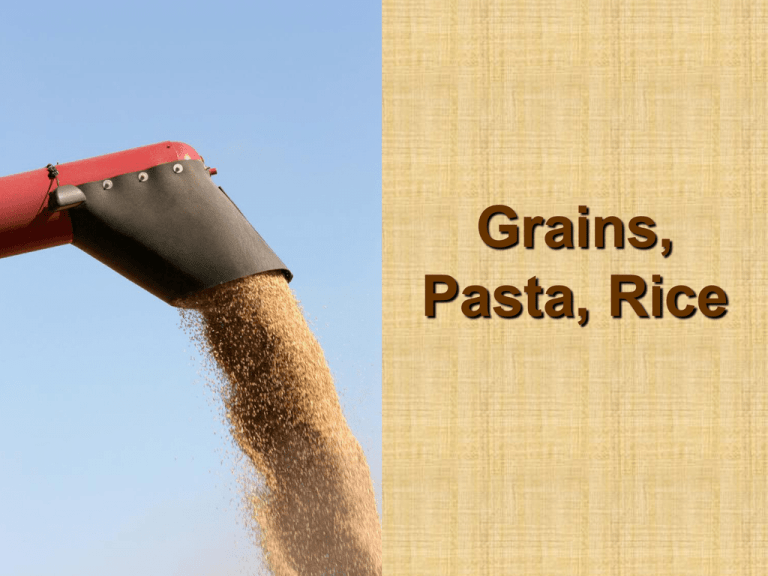
Grains, Pasta, Rice Grains • Definition: single, hard seed • Most common grains – Wheat – Corn – Rice Kernel of Wheat HUSK What’s a Whole Grain? • Whole Grains: Made from entire kernel including bran, germ, endosperm. • Refined grains: Milled so germ and bran are removed. • Enriched: Adding nutrients lost during the processing of the grain back into the finished product ex. White flour. Why do Whole Grains Matter? • Diets rich in whole grain foods and other plant foods, and low in saturated fat and cholesterol, may help reduce the risk of heart disease • Consuming at least 3 or more ounce-equivalents of whole grains per day can reduce the risk of several chronic diseases and may help with weight maintenance – High fiber – Low fat – More calcium -High in B Vitamins -Rich Sources of Minerals Wheat Cont… • Common Wheat: used for flour • Durum Wheat: type of wheat with high protein and gluten contents – Semolina: Endosperm only of Durum wheat • Couscous: Granular form of semolina – Bulgur: cracked durum wheat that has been parboiled, dried, then cracked • Spelt: Type of wheat PASTA • Pasta is usually made from DURHAM wheat because of its high protein and gluten. • Pasta test for doneness- al dente (meaning firm to the tooth) • Pasta doubles as it cooks. 1 cup uncooked pasta will yield 2 cups cooked. • To Cook: • • • • • Boil a large pot of water Add pasta once boiling Cook 10 minutes Drain Toss with oil to prevent it from sticking together Other Grains Less Popular • Barley • Oats • Rye Uncommon Grains • Quinoa • Kamut • Amarantha • Buckwheat Less Popular Grains Barley • Barley contains all eight amino acids • According to a recent study, eating whole grain barley can regulate blood sugar for up to 10 hours after consumption Oats •Oats contain more soluble fiber than any other grain, resulting in slower digestion and an extended sensation of fullness •Oats soluble fiber lower bad cholesterol therefore decreasing your risks of heart disease. Less Popular Grains Rye • Commonly made into flour for rye bread • Triticale: hybrid grain that is a cross between wheat and rye Uncommon Grains Kamut Quinoa •Larger seed size in comparison to wheat • •Contains 30-40% more protein than wheat • Seeds that are covered in bitterness preventing insect/bird damage High protein content (12-18%); complete protein (balanced set of amino acids) Uncommon Grains Amaranth • have a 30% higher protein value than other cereals, such as rice, wheat flour, oats, and rye • Contains a complete protein and a high amount of manganese Buckwheat • contains no gluten; • is not related to wheat – Kasha: roasted buckwheat that’s ground or cracked Processing Grains • • • • Berries: whole grain minus the hull Flour: ground into fine powder Rolled = Flaked: flattened between rollers Cracked: cut into small pieces to speed up cooking time • Pearled: bran removed and tumbled Rice Worldwide there are more than 40,000 different varieties of rice! Basic Categories of Rice • Long grain Rice- Long, polished kernels. Bland and somewhat firm in texture. Yields a drier, fluffy rice. – Ex. Basmati and Jasmine • Medium Grain Rice- has a shorter, wider kernel (two to three times longer than its width) than long grain rice. Cooked grains are more moist and tender, and have a greater tendency to cling together than long grain. – Ex. Sushi Rice • Short Grain Rice- Short grain rice has a short, plump, almost round kernel. Cooked grains are soft and cling together. – Ex. Arborio Rice Nutritional Differences of Rice • Brown Rice- the whole grain form of rice with only the husk removed • Parboiled Rice- steam was passed through the grains with the husks on. The nutrients are embedded into the grain by this procedure. The rice is polished after this steaming is done. This results in more nutritious rice than white rice and more digestible rice than brown rice. • Instant Rice- Precooked and they dehydrated, cooks quickly and the yield is doubled. Cooking Rice • Double the amount of water for rice. (1:2 ratio) 1. 2. 3. 4. 5. 6. • Bring water to boil. Add and stir in rice. Turn heat to low and put on lid. Cook for 20-25 minutes (parboiled) 45-1hr (brown rice). Rice is done if no water is visible. Fluff with a fork. Rice Triples as it cooks. 1 cup uncooked rice yields 3 cups of cooked rice.
